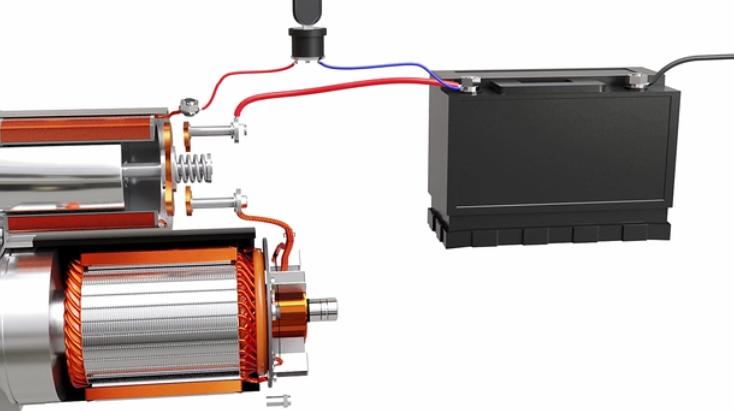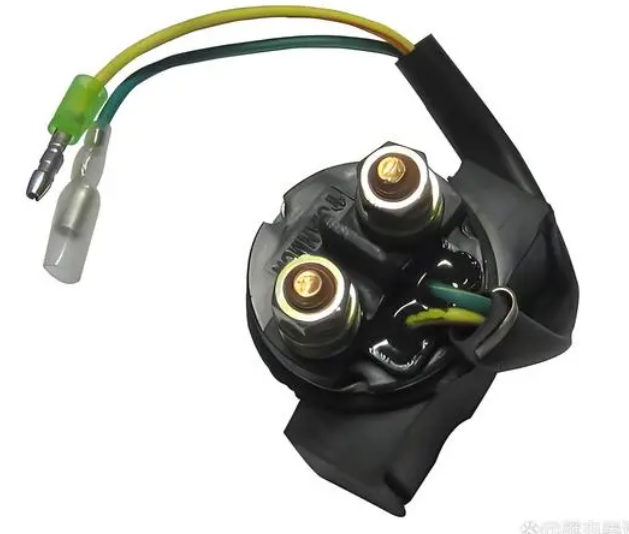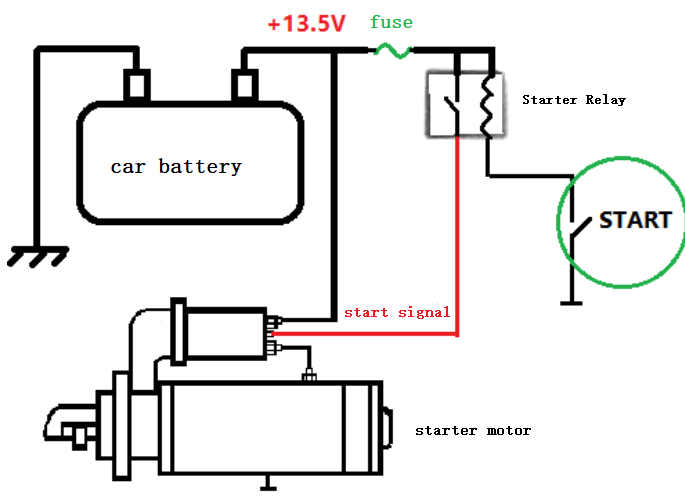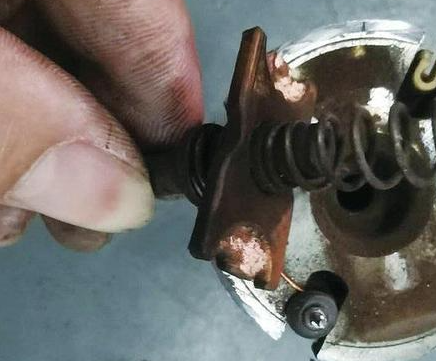The starter relay is the most important and often overlooked part of a car's ignition and starting system. Its role is to redirect power from the battery to the starter solenoid, which then engages the starter to crank the engine. Only when the relay operates correctly can you start and operate the vehicle normally.
The relay is a component crucial to whether your car can run. Once it wears out, it can affect your driving safety. Therefore, whether you are currently experiencing relay issues or not, you should have an understanding of its definition, function, location, and more.
What is starting system
Before explaining the starter relay, we first need to understand the starting system. In a car, the starting system is an independent system used to start the engine. This system includes electrical components such as the starter motor, starter relay, fuses, and ignition switch, which work together to start the engine.
 figure 1. The components of a starting system
figure 1. The components of a starting system
What is a starter relay
The starter relay is one of the components of the starting system. Also known as the starter solenoid relay, it is a small electronic component typically located near the battery and starter motor of a vehicle. Its role is to transmit current to the starter motor when you turn the key to start the car, causing the engine to turn over and start. Acting as a switch, it controls the high current flow from the vehicle's battery to the starter motor.
The starter relay is typically a small, rectangular or cylindrical component with multiple electrical terminals for wire connections. It may have a plastic casing, a metal mounting bracket, and electrical connectors for ease of installation.

figure 2: starter relay
The starter relay consists of an electromagnetic mechanism and a contact assembly. Its coil is connected to the ignition switch terminal and ground terminal "E" on the housing, while the fixed contact is connected to the starter motor terminal "S," and the movable contact is connected to the battery terminal "BAT" via the contact arm and bracket. Under normal conditions, the contacts of the starter relay are normally open. When the coil is energized, the relay's armature generates electromagnetic force, causing the contacts to close, thereby connecting the relay's control and holding coil circuits, activating the starting system. Below is a wiring diagram of the starter relay.

figure 3: starter relay wiring diagram
ALSO READ: What is a Solenoid Switch and How Does It Work?
What is the purpose of a starting relay
-
It connects the motor power supply to provide the necessary current for the motor to start and ensure its normal operation. For instance, in a car, the starter relay uses low current to control the high current needed to start the motor, which rotates the internal magnetic rotor of the generator, sends ignition pulse signals to the spark plug, ignites the fuel-air mixture in the cylinder, and generates power. Similarly, in a refrigerator, the starter relay allows the motor winding to be energized during compressor startup.
The ignition relay is responsible for supplying power to the ignition system to enable the ignition coil to produce sparks for igniting the fuel-air mixture. The starter relay works by receiving signals from the ignition switch and collaborates with the ignition relay to maintain the engine's normal operation.
-
It disengages the pull-in coil. Once the motor reaches a certain speed or completes the starting process, the starter relay disconnects the pull-in coil to prevent unnecessary power consumption and component wear.
-
It maintains the stability and reliability of the motor's operation by ensuring the proper functioning of the holding coil circuit.
In practical applications, the starter relay should be selected based on the load current. For currents below 10A, it can directly control the circuit by opening and closing the contacts. For currents exceeding 10A, it should be used as an indirect controlling component.
How a starter relay works
The starter relay is an electromagnetic relay that, compared to standard relays, operates at lower coil voltages and has a higher switching capacity. When the coil is energized, it generates a magnetic field that attracts or releases the contacts, thus controlling the switching of the circuit. During motor startup, the starter relay plays a role in switching between the motor's starting current and running current.
Where is the starter relay located in a car
The position of the starter relay varies depending on the vehicle model but is typically located inside the engine compartment's fuse box or the interior fuse box. In some models, the relay may be mounted under the dashboard or beside the driver's seat inside the cabin.
For specific models such as the Ford F150, the starter relay fuse is usually located in the engine compartment's fuse box or the central junction box inside the vehicle. For example, in the 2015-2018 Ford F150, the starter relay fuse, marked as 30 amps, is situated in the fuse box.
In Harley-Davidson motorcycles, the starter relay might be located in the extension of the rear fender or near the battery compartment, with the exact position potentially varying based on the model year.
What are the symptoms of a faulty starter relay
when starter relay goes bad, the ignition process may exhibit the following symptoms:
-
After activating the ignition switch, the starter motor spins rapidly, but the engine crankshaft remains stationary. This could indicate issues with the starter motor's transmission system, possibly due to worn transmission gears or a faulty one-way clutch.
-
Even if the drive gear rotates, the starter motor fails to engage the engine properly. This situation could stem from various causes such as power line issues, damaged contacts in the ignition switch, or abnormally high engine resistance.
-
The starter motor lacks sufficient force to drive the crankshaft properly. This may result from a short circuit in the excitation coil or insufficient power from the battery.
-
If a sharp noise emanates from the starter motor, it could be due to a stuck one-way clutch or improper installation of the starter motor.
-
When the starter switch clicks but the starter motor does not turn, this usually indicates a problem in the starting system. It may be caused by a disconnected holding coil or severe battery power depletion.
-
When the starter relay works intermittently, the vehicle may experience intermittent starting issues. Factors such as oxidation, rust, and carbon buildup on the contact surfaces can hinder the flow of current in the circuit, leading to unstable power transmission from the starter relay to the starter motor, resulting in intermittent starting problems. Additionally, internal aging or damage to the relay's electromagnet may prevent it from consistently providing enough force to close the contact points, causing intermittent operation of the starter relay and resulting in sporadic starting performance in the vehicle.
How to fix starter relay
 figure 4: How to fix starter relay?
figure 4: How to fix starter relay?
- Check Battery and Connections: Ensure the battery is fully charged and that the battery terminals and connections are free from corrosion or looseness. Insufficient battery power could cause the starter relay to malfunction.
- Tap the Starter Motor: If the starter relay has minor corrosion or debris inside, try gently tapping the starter motor; this may help dislodge the corrosion or debris temporarily, restoring starting function.
- Push-Start: If the vehicle can be pushed, attempt to push the vehicle to a certain speed, then release the clutch; sometimes this can start the engine. Note that this method requires a certain speed, typically around 8-10 miles per hour.
- Jump-Start: If there are noises when attempting to start the vehicle but it doesn't start, it might be a battery issue rather than a starter relay problem. Try jump-starting from another vehicle's battery.
- Check Headlights: Turn on the headlights while attempting to start. If the headlights come on but the vehicle doesn't start, it may indicate a problem with the starter relay. If the headlights don't come on, the issue might be with the battery.
- Professional Diagnosis: If you are unsure how to perform these checks or encounter difficulties during the process, it is advisable to seek assistance from a professional auto repair technician for diagnosis and repair.
- Replace Starter Relay: If it is confirmed that the issue lies with the starter relay, the cost of replacing a starter relay typically ranges from $50 to $75, including parts and labor costs. If you have some automotive repair skills, you may also consider replacing the starter relay yourself.
How to check a starter relay fuse
When discussing starter relay issues, a potential cause of starting problems could be related to fuses. Checking if the relevant fuses are damaged or blown when the starter relay fails to function properly can help pinpoint the root of the problem. Therefore, when dealing with starter relay faults, inspecting and replacing fuses is an essential maintenance step.
- Firstly, you need to locate the vehicle's fuse box. In many vehicles, the fuse box is typically located in the engine compartment or near the dashboard inside the vehicle.
- Next, inspect the fuses related to the starter relay to see if there are signs of breakage or melting. If the fuse appears blackened or the internal metal wire is broken, the fuse is likely blown. Additionally, if you smell a burnt odor, it could indicate overload or a short circuit.
- To accurately determine if a fuse is blown, you can use a multimeter to test the fuse's continuity. Set the multimeter to continuity or resistance mode, then touch the probes to the two ends of the fuse. If the fuse is good, the multimeter will emit a sound or show low resistance; if the fuse is blown, the multimeter will display high resistance or no continuity.
If it is confirmed that the fuse is blown, you will need to replace it with a new fuse. Ensure that the new fuse's current rating matches the original fuse to ensure the circuit operates normally. After replacing the fuse, try starting the vehicle to confirm if the issue has been resolved.
How to test the Starter Relay
Inspecting the fuse is only part of the troubleshooting process; further examination of the starter relay is necessary to ensure that all components of the starting system are functioning properly. If the fuse is found to be intact through the above checks, then testing the starter relay is also essential, as a faulty starter relay can prevent current from being delivered to the starter motor, affecting the vehicle's starting. To test whether the starter relay is working properly, you can use a multimeter or test it without one. Here are the steps for both methods:
How to test a startering relay with a multimeter:
1. Prepare the multimeter : Set the multimeter to resistance measurement mode and ensure the appropriate resistance range is selected (usually 200Ω).
2. Measure the coil resistance : Connect the multimeter probes to the relay's coil terminals (usually labeled 85 and 86). If the relay coil is in good condition, the multimeter will display a resistance reading between 50Ω and 200Ω. If the reading is outside this range or shows "O.L," it may indicate a problem with the relay coil.
3. Activate the relay and test the contacts : Use a 12-volt battery and jumper wires to connect to the relay's 86 and 85 terminals to activate the relay. Then, measure the resistance between the 30 and 87 terminals. If the circuit is working properly, the reading should be between 0.2Ω and 0.5Ω, indicating almost no resistance.
4. Check the relay's engagement : When the relay is activated, you should hear a click, indicating that the contact has switched from terminal 87a (normally closed) to terminal 87 (normally open). If you don't hear a click, the relay may be faulty.
How to test a starterng relay without a multimeter:
1. Visual and auditory inspection : First, visually inspect the relay for any obvious damage, such as burn marks or broken terminals. Then, attempt to start the vehicle and listen carefully for a click from the relay. If the relay emits a weak or unusual sound, it may indicate a problem.
2. Use a test light : Use a test light or a continuity tester to check the relay's power and ground terminals. When the ignition switch is activated, the test light should illuminate, indicating that the power supply is normal. If the test light does not light up, it may indicate a problem with the relay or its circuit.
3. Shorting test : If you suspect that the relay's contacts are not engaging properly, you can try shorting the two contact terminals of the relay (usually 85 and 86) with a piece of wire or a screwdriver. If the relay is working correctly, you should hear the starter motor respond. If there is no reaction, the relay may be faulty.
4. Check connections : Ensure that all connections to the relay are secure and free from corrosion. Loose or corroded connections can cause the relay to work intermittently or not at all.
5. Replacement test : If possible, you can try temporarily replacing the starter relay to determine if the problem is resolved. If the issue disappears after the replacement, then the original relay was indeed the problem.
Normally, the lifespan of a starter relay exceeds 100,000 miles. These components are highly durable because they have very few moving parts, resulting in minimal wear and tear. The most common threat to the longevity of a starter relay is typically the burning of the contact points. The cost of replacing a starter relay can vary based on several factors, including the vehicle's manufacturer, model, location, pricing policies of repair shops, and the quality of the parts used. Generally, the average replacement cost of a starter relay itself ranges from $50 to $75, depending on the vehicle model and labor costs. The cost of the starter relay part is approximately around $20, with labor costs ranging from $30 to $55.
If you are considering replacing the starter relay, it is advisable to contact multiple repair shops, inquire about their pricing, compare prices and services, and then make a decision.
Conclusion
In summary, ensuring the proper functioning of the starter relay is crucial as part of regular vehicle maintenance practices. It can help you avoid starting issues and prevent being stranded in remote areas. Regularly inspecting and maintaining the vehicle's electrical system, including fuses and the starter relay, is an important measure to ensure the reliability and safety of the vehicle. Timely repairs or replacement of faulty starter relays can help prevent potential starting failures and ensure that the vehicle remains in good working condition.






